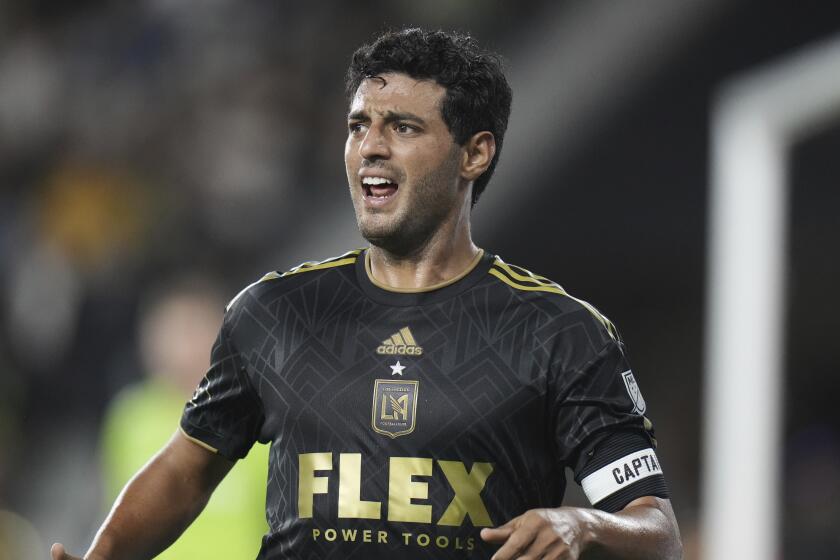Plusses and Minuses of Horn on the Horn
- Share via
Anyone who has ever put on a football helmet dreams of scoring a touchdown.
To cross the goal line with the football is considered special for good reason. It’s the only time that the game stops and all eyes are on one player. It’s one play that always makes a player’s day.
For an athlete who does not score often, a touchdown celebrations is usually genuine.
He holds the ball high over his head and freezes for a moment while he thinks of what to do next. Then the player either spikes the ball to the ground with all his might or does some type of spontaneous move to celebrate his touchdown.
Then there are the players who seem to score all the time. Most of them are receivers or running backs. Some come up with their own trademark move such as Kansas City running back Priest Holmes’ slide step into the end zone. Others avoided celebrating, such as former Detroit running back Barry Sanders, who usually just handed the ball to an official.
Then there are players who have taken touchdown celebrations to a new level.
It still makes some viewers almost sick to their stomachs when they see a player twist, grind and pump after making a basic football play, but there are also others who are entertained by today’s breed of big-ego players who spend hours thinking of new ways to celebrate a touchdown.
It’s no secret that self-promoting athletes normally get more media attention than players who simply do their job.
Call it the Deion Sanders factor.
Sanders was the master of this approach and made a lot of money because of his entertainment value. Sanders’ dancing revolutionized on-field celebrations for the modern football player. He made it cool to play cornerback in the NFL.
Sanders was not the first to bring attention to himself on the field; he won’t be the last.
That’s why it’s interesting to hear all the criticism aimed at New Orleans wide receiver Joe Horn, who planted a cellular phone in the goal post padding and made a call after one of his four touchdowns against the New York Giants last week.
Sports talk radio hosts around the country have attacked him, and some marketing experts even predicted that Horn cost himself potential income outside of football.
Horn’s critics claim his act was a negative for football because it wasn’t spontaneous. But his touchdown maneuver was no less premeditated than Houston Oiler Ernest Givens’ electric slide or Green Bay Packer Robert Brooks’ Lambeau Leap.
What Horn did was attract national attention -- which hadn’t been happening playing for the little-publicized Saints.
He finished with nine catches for 119 yards against the Giants, giving him 19 games with at least 100 yards receiving in his career. Horn has caught at least one pass in 76 consecutive games, 62 since he joined the Saints in 2002.
But despite his impressive numbers, not many people were talking about him until his cellphone call. For better or worse, they are now.
The NFL has a long history of innovative end zone celebrations and survived every one. From the Dirty Birds and Mile High Salutes to the Fun Bunch and the Ickey Shuffle, the league has ridden one wave of individual moves after another.
Horn was fined $30,000 for his cellphone act; San Francisco’s Terrell Owens reached six figures in total league fines years ago. But the NFL’s most effective method of keeping celebrations under control rests with the players themselves.
Football is an emotional sport, and no one likes to be embarrassed. Sooner or later, showboat players usually pay a price. That’s just the nature of the sport.
More to Read
Go beyond the scoreboard
Get the latest on L.A.'s teams in the daily Sports Report newsletter.
You may occasionally receive promotional content from the Los Angeles Times.










